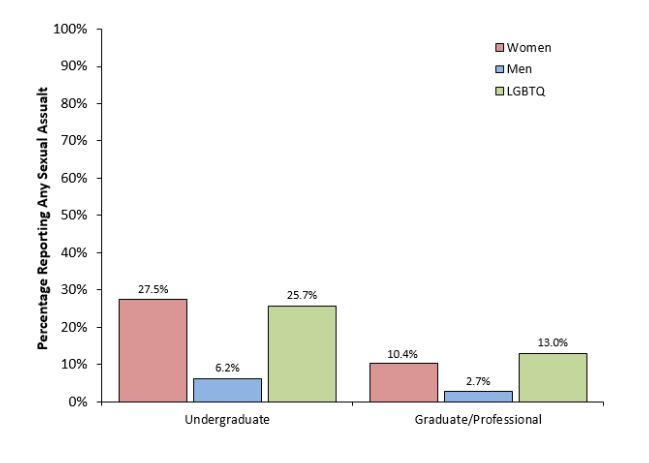You have /5 articles left.
Sign up for a free account or log in.

Percentages of Penn State students reporting at least one incident of sexual assault, broken down by gender
Penn State
Just over half of Pennsylvania State University students who experience stalking, dating violence or sexual assault ever tell someone about the incident, according to a new survey of the university’s students, and only a tiny fraction of those students report the assaults to police or campus officials.
Victims of such crimes are far likelier to tell friends, romantic partners and family members about the experience, the survey found.
“My real takeaway from this survey is that I’ve got a lot of work to do,” said Paul Apicella, the university’s Title IX coordinator. “One of the things that concerned me most is that the reporting numbers are relatively low. Like all good research, this has given us some answers and data that then begs a hundred different questions that we need to look at.”
The survey, a modified version of a questionnaire created by the Administrator Researcher Campus Climate Collaborative, asked students at Penn State about a variety of gender-based crimes on campus, including stalking, dating violence, sexual harassment and rape. About 11 percent of undergraduate students reported experiencing dating violence and 20 percent reported being the victim of stalking.
Similar to other campus climate surveys conducted in the past year, 24 percent of undergraduate students said they had been the victim of “unwanted touching, penetration or attempted penetration,” including kissing and groping. About 18 percent said they had been victims of “at least one instance of complete or attempted oral, vaginal or anal sexual assault.”
Women were more likely than men to have experienced assault. More than one-third of female undergraduate students reported experiencing unwanted touching, penetration or attempted penetration. Nearly 28 percent said they had been the victim of completed or attempted oral, vaginal or anal sexual assault. Gay, lesbian, bisexual and transgender students also were more likely to report being victims of sexual assault than was the average student, with about one-third saying they had been victims of unwanted touching, penetration or attempted penetration, and 25 percent reporting having been the victim of completed or attempted oral, vaginal or anal sexual assault
“I think what we learned is no surprise, and that is this is a significant problem with our student community,” Damon Sims, Penn State’s vice president for student affairs, said. “They are concerned about it and we must continue to be concerned about it. It’s not news to us, but the survey reaffirmed some suspicions we had.”
Of undergraduate women who reported being the victim of stalking, dating violence or sexual assault, 56 percent told someone about the incidents, as did 37 percent of men and 58 percent of LGBTQ students. Over all, only 2.6 percent of undergraduates went to campus or local police, and about 3 percent reported the incident to the university’s office of student conduct.
More than 86 percent of the undergraduate students who told someone about their assaults chose to tell their close friends about what happened and about 70 percent told their roommates. About 17 percent told their parents or guardians and 10 percent told another family member.
After seeing these findings, Sims said, the university is now focused on improving its bystander intervention education, as well as reaching out to parents through its Parents Council.
“The data show that students tend to report incidents related to sexual misconduct to friends and peers and family members and parents, not to us,” he said. “I want to start a conversation with the parents' program about how best to communicate messages around sexual misconduct. We’re trying to figure how to enlist their aid in trying to tackle the issue.”
The survey also asked students why they chose not to report incidents of stalking, dating violence and sexual assault to authorities. One-quarter of undergraduate students said they were too embarrassed and 65 percent said it was because they felt “it would cause more trouble than it was worth.”
There also seemed to be some confusion, the survey found, about how to report sexual misconduct. Nearly 58 percent of undergraduate students said they did not know how to report an incident, and 59 percent said they did not know “where to go to get help if someone” they know experienced sexual misconduct.
The issue is not unique to Penn State. Despite increased awareness in recent years of the issue of campus sexual assault, several campus surveys and studies have found that many students struggle to locate information about how to report and prevent sexual assault.
Even with their apprehension to come forward, Penn State students responding to the survey said they had relatively high confidence in how seriously the university would take their complaints if they chose to do so. More than 70 percent of undergraduate women said the institution would take their report seriously, compared to 57 percent of women who responded affirmatively to that question in a similar Association of American Universities survey last year.
"I'm pleased to see we are doing reasonably well in that area," Sims said. "That was nice to see, but there clearly are issues we still need to tackle."




